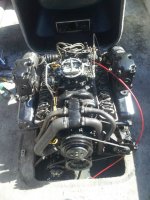1995 Mercruiser 350 Tournament Ski Direct Drive in a 1995 Ski Sanger DLX 20 tournament tow boat. Anybody have a rough idea of the top temp under the engine cover? (I don't have any automotive/scientific measuring devices. Maybe I could use my instant-read meat thermometer?) Not talking about engine operating temp, but the space around the engine and bilge. I want to install a fuel shut off in the fuel line that runs on the starboard side of the boat, and I want to make sure the valve I install will operate safely in the temp in there. Please don't overthink this. I have a reason to do this and want to do it safely. If you can't come up with a number, that's OK. If you can reference a part you think is right for the job, even better. Knowledge helps, not opinion. Let's not get into a 40-post discussion. Many thanks for your help.
Home
Outboard Motor Parts
Chrysler outboard parts Evinrude outboard parts Force outboard parts Honda outboard parts Johnson outboard parts Mariner outboard parts Mercury outboard parts Suzuki outboard parts Tohatsu outboard parts Yamaha outboard partsInboard & Sterndrive Engine Parts
Chrysler Marine inboard parts Crusader Marine parts MerCruiser sterndrive parts OMC sterndrive parts Pleasurecraft Marine parts Volvo Penta marine parts + MoreAll Engine Brands
All Manuals HomeOutboard Repair Manuals
Chrysler outboard manuals Evinrude outboard manuals Force outboard manuals Honda outboard manuals Johnson outboard manuals Mariner outboard manualsMercury outboard manuals Nissan outboard manuals Suzuki outboard manuals Tohatsu outboard manuals Yamaha outboard manuals
Inboard & Sterndrive Engine Manuals
MerCruiser sterndrive manuals OMC sterndrive manuals Volvo Penta marine engine manualsPlease Note
MarineEngine.com does not offer troubleshooting assistance or repair advice by email or by telephone.
You are invited to join our public Boat Repair Forum to seek assistance from other members.
You may also visit the Boat Motor Manuals section of our site to obtain a service manual.


